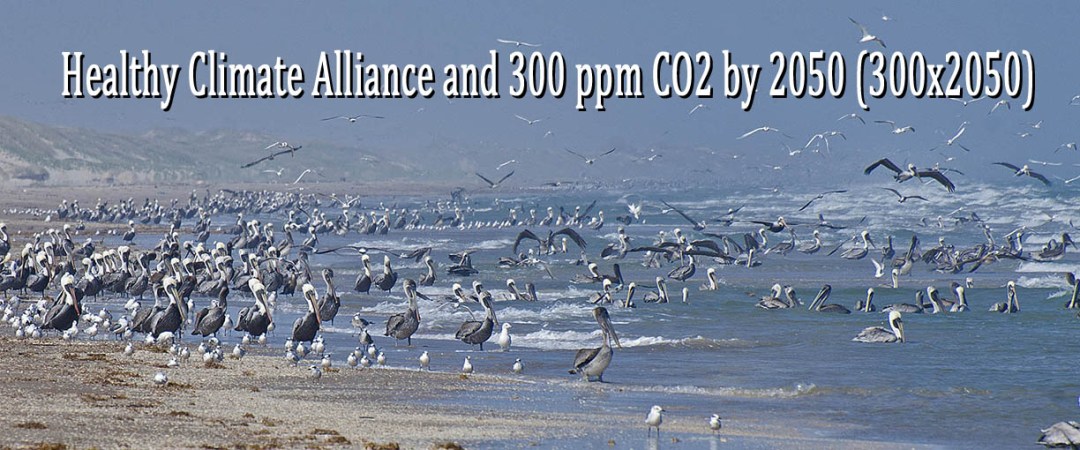
Emissions reductions alone allow Earth’s temperature to continue to rise, sea level to continue to climb, and our beaches to mostly disappear. What can we do to not only prevent this from happening, but to reverse the dramatic increase in extreme weather we have seen lately?
Healthy Climate Alliance and 300 ppm CO2 by 2050 (300×2050)
The Healthy Climate Alliance asks, why aren’t we seeking to restore our climate to its original healthy state? The answer for 30 years has been that limiting emissions was enough. We could decarbonize our infrastructure, limit warming to 2 degrees C and let nature take its course.
This 30 year-old philosophy isn’t working out so well, either in academia or in real life. A growing number of scientists, advocates, business people, elected leaders, and citizens are realizing that even 1 C or warming is far too much. The Healthy Climate Alliance and 300×2050 have both been founded to do something about moving our legacy climate reform culture into the twenty-first century.
Healthy Climate Alliance
300×2050
Forbes, The Man With The 300 / 2050 Vision
With the rapid increase in extreme weather lately, and the initiation of abrupt changes, climate reform culture is changing. There is no science today that says we can keep warming under 2 degrees C with emissions reductions alone. And now, in 2018, the biggest climate science consensus in the world, the Intergovernmental Panel on Climate Change (IPCC), is going to release a report on the new limit to dangerous climate change of 1.5 C.
Since the 2013 IPCC report though, we have known that we will need large negative emissions to limit warming to 2 C. Negative emissions are any combination of strategies and technologies that allow us to remove more CO2 from our atmosphere than we put there every year. The quantity of negative emissions then is that amount of CO2 in addition to 100 percent emissions reductions, or “net zero” emissions.
So because 1 C warming is already dangerous, and large negative emissions are needed to limit warming to 2 C, we have no choice. We must implement emissions reductions strategies, rule and law, and in addition, begin not only large, but very large negative emissions.
Simply limiting warming to 1.5 C requires negative emissions of 9 to 32 gigatons of CO2 annually until 2100. This is in addition to full implementation of the Paris agreement of 80 percent reduction in emissions by 2050 and net zero by 2080.
We have the science to do these negative emissions–we’ve had it since World War II. And now we are seeing new advanced technologies and strategies being developed that can do the job better than older mature technologies.
We first started taking carbon dioxide out of the air in submarines to keep our sailors safe in World War II. In Squamish, British Columbia today, there is an industrial scale pilot project taking carbon dioxide out of the air for $75 a ton with this exact same technology. It uses simple lye (sodium hydroxide).
We can use the CO2 we take out of the air, or we can safely store it underground, or in the oceans, or by building mountains with it. As a quick example of the potential for beneficial use, globally we use 50 Gt +/- aggregates yearly. Using CO2 to create aggregates at as little as $5/ton opens up markets for aggregates made from captured CO2 that could plausible move far into negative emissions territory. (See Blue Planet )
The technologies are there waiting to be mechanized and industrialized. With the current direction of politics, and climate change progressing into the much more extreme phase of impacts, with waring now increasing on its own because of feedbacks, new alternatives are needed.

